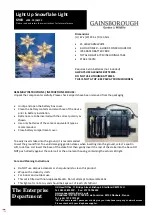
24
Combining Ports
It is sometimes necessary to combine an input and an output
of the multiplexer to connect to an instrument. One of the
most common cases is the connection between a GPS and the
multiplexer. While some GPS receivers have properly designed
NMEA ports, many only have an RS-232 port which is single
ended with three terminals: TxD (data out), RxD (data in) and
Ground. Figure 24 shows how to connect such a GPS to the
multiplexer.
SeaTalk
SeaTalk
®
is a proprietary protocol developed by Raymarine
®
. This protocol is used for communication
between Raymarine navigation instruments like the ST40, ST50 and ST60 series.
To be able to use these instruments with commonly available navigation programs or to feed their data
into other non-Raymarine instruments, the SeaTalk data needs to be translated into NMEA. Even
Raymarine’s own navigation software, Raytech Navigator, needs this translation.
The MiniPlex can be directly connected to a SeaTalk
network. It will translate all SeaTalk data required for
navigation into NMEA sentences. Input In 4 can be set to
SeaTalk mode (“SeaTalk -> NMEA”) and should be
connected as shown in Figure 25.
Note that the
red
and
yellow
wires are used! The shield of
the SeaTalk cable is not connected to the multiplexer.
Figure 26 shows how to power the MiniPlex from the
SeaTalk network. The red wire is connected to both In4A
and the power terminal and the shield of the SeaTalk
cable is connected to the power ground terminal.
Figure 24: Connecting a GPS with a serial port
to the multiplexer.
GPS
TxD/Out
Ground
RxD/In
Multiplexer
In A
In B
Out A
Out B
Com
Gnd
SeaTalk cable
Multiplexer
In 4A
In 4B
Red
Yellow
Figure 25
SeaTalk cable
Multiplexer
In 4A
In 4B
Red
Yellow
+12V
Gnd
Figure 26: Power and data from the SeaTalk
network.
















































